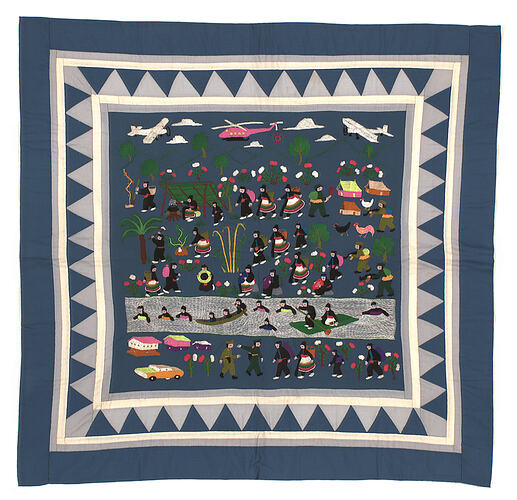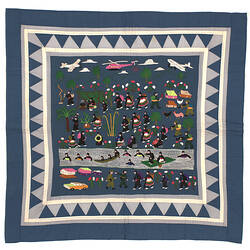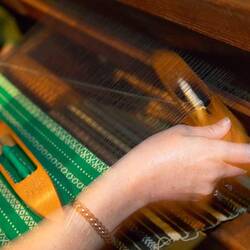Summary
Embroidered banner made by members of the Hmong community in Victoria, circa 1985-1992. It tells the story of the Hmong's migration from Laos. The Victorian Hmong community developed after many Hmong fled from Laos in 1975 and arrived in Australia in mid 1980s after spending time in Thai refugee camps. The women of the Victorian Hmong community produced and sold these types of works at the Fitzroy Craft Market to supplement family income.
The embroidered design in the centre depicts the migration of the Hmong people from their homeland. It shows a village scene with one soldier about to set fire to the huts and others pointing guns at Hmong people. There are scenes depicting work and the journey. there are images of aircraft flying overhead. A river is shown, with people crossing it by canoe, raft, inflated tubes or by swimming. At the bottom of the banner, refugees are directed to houses by uniformed men.
Fine needlework has always been a source of great pride to Hmong women and girls are taught to sew at age seven or eight. This type of embroidered panel is "Paj Ntaub Tib Neeg" also called "story cloth." These pictorial embroideries developed very recently in Hmong history, when Hmong men began to draw elements of traditional Hmong stories to help make sure they would be remembered during the times of change. Women began to have the men draw these pictures onto fabric so that they could stitch the stories on cloth.
Physical Description
Banner consists of an embroidered design on blue background inside a border. There is an appliqued border consisting of a plain blue band on the outer edge, a narrow band in grey, then one in white, a zigzag pattern of blue and grey, and finally two narrow bands in white and grey.
More Information
-
Collection Names
-
Collecting Areas
-
Acquisition Information
Purchase
-
Place & Date Made
Hmong Community, Melbourne, Greater Melbourne, Victoria, Australia, 1985-1992
-
Place & Date Used
Hmong Women's Stall, Fitzroy, Greater Melbourne, Victoria, Australia, 1992
-
Classification
Cultural identity, Ethnicity - creative practice, Needlework
-
Category
-
Discipline
-
Type of item
-
Overall Dimensions
86 cm (Length), 82 cm (Height)
-
Exhibition Collection Management
86 mm (Length), 82 mm (Height)
-
Keywords
Cultural Identity, Cultural Maintenance, Ethnic Groups, Handcrafts, Hmong, Refugees


